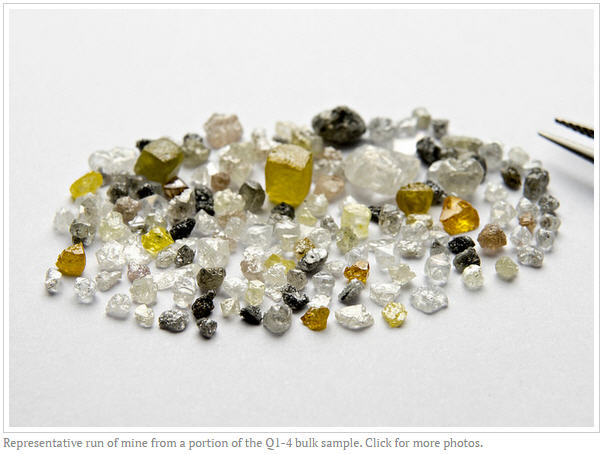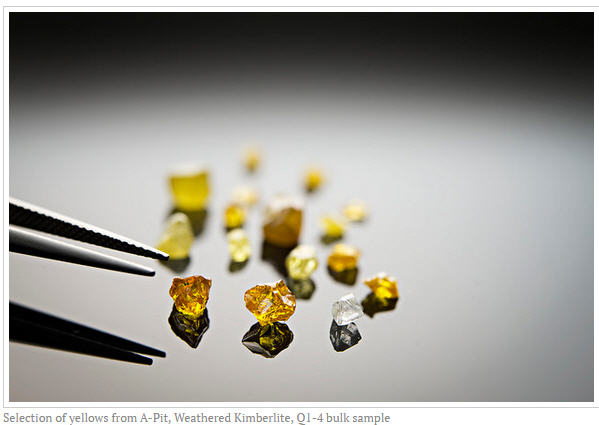Lukas Lundin “very encouraged” by North Arrow bulk sample
A tight community of stock brokers, promoters and Canadian diamond investors saw some excitement today as North Arrow Minerals (NAR.V), a diamond explorer with active projects in Nunavut, Saskatchewan and elsewhere in Canada, halted its stock pending news.
Over at our financial news chat application, chat.ceo.ca, users started speculating whether it would be drill results from the Pikoo project in Saskatchewan, or results from a bulk sample test at the company’s Qilalugaq diamond project in Nunavut.
Sure enough, North Arrow published preliminary results from the anticipated Qilalugaq Q1-4 bulk sample at the close (news release here). The company reported initial diamond recoveries from the first 609 tonnes or 46% of the bulk sample tonnes collected in Summer of last year, and recoveries were, depending on what side of the coin you’re on, negative or very positive (I’m in this camp, but biased). Of significance, 2 +4 Carat Yellow stones were recovered in the parcel.
Not being a diamond expert, I wanted to better understand today’s results, so I called up a friend who has been around since the beginning of Canada’s diamond business. He had to call me back. When we eventually spoke, he commented the project is early and the results are preliminary, but the colours of the yellows seen in the sample were “sub-optimal,” in his opinion.
Next I rang John Kaiser of Kaiser Research who agreed with the first assessment. Kaiser thought the diamond value would not be nearly high enough to justify a mine in the North.
I had kind of expected the two gentlemen to poo-poo on North Arrow a little bit, because they already have their own plays in the diamond space.
To get a little perspective, I called up Lukas Lundin, who runs the Lundin Group of global natural resources companies. Lundin family trusts own at least 19.5% of North Arrow’s stock, and based on intermittent conversations with Lundin over the past two years, I know he is interested in and optimistic for the Q1-4 bulk sample and valuation. By the time I called, he hadn’t seen the press release yet, and I so agreed to call him back.
Twenty minutes later, Mr. Lundin had discussed North Arrow’s press release with Lucara Diamond CEO William Lamb. Lucara is the Lundin family’s diamond production business, worth roughly $800 million and currently generating 80%+ operating margins at the company’s flagship Karowe Mine in Botswana.
“I just talked to William,” Lundin said. “It’s very encouraging, this is a big deal.”
The enthusiastic tycoon granted my request to share his comments with CEO.ca readers.
Lundin, always on the move, had to go, and shortly thereafter I heard back from my anonymous friend as well as Kaiser.
Anonymous thought the diamond grade had gone down, and could be bad for the market. North Arrow CEO Ken Armstrong later disputed this.
Mr. Kaiser said some of the white diamonds looked good, but he was not a fan of the yellows, and said words like “aggregate” and “cubic” are negative descriptors for diamonds.
In chat.ceo.ca, “Einhorn 78″ said the company was clearly putting out news ahead of next week’s PDAC conference, and noted that the Mountain Province Diamonds Gacho Kue mine in construction had 6x the grade as North Arrow’s Qilalugac deposit.
I wanted to discuss these comments with North Arrow’s CEO Ken Armstrong, who after a busy afternoon of discussing the results with various interested parties, spent 15 minutes on the phone with me just before 4pm Pacific Time.
Armstrong knew he would face inevitable questions at the PDAC, including, “what are you seeing, what do they look like, how big are they, and are their any yellows. The intent of the release was to try to answer some of those questions and provide a bit of context.”
The main conclusion to make, according to Armstrong, despite being only 46% through processing the bulk sample, is that the yellow diamonds are clearly part of the population in Q1-4 and they carry on into the larger diamond sizes. This was one of the main questions North Arrow wanted to answer, and in fact the three biggest stones recovered are Yellows.
“The proportion of yellows increases with increasing stone size. I think we see enough in this parcel to say that this is real.”
“The questions that we wanted to answer as part of this sample: Can we collect it, can we ship it, can we process it, are the yellows there, are they part of the population, are they big enough and do they carry on, every answer has been yes so far. The next big answer will be, what is the dollar value. That’s going to be the major question.”
North Arrow will carry on processing the remainder of the sample, and the important diamond value, that comes from Antwerp, is expected in April or May.
“The grade hasn’t gone down, it matches exactly to the grade that Stornaway got from the 20 tonnes they collected in the same location of the pipe as this sample,” Armstrong said of my anonymous friend’s comments.
Of the Mountain Province comparison, Armstrong said value is more relevant than grade, but conceded their grade could be 5x greater.
“We have never pretended to be a Mountain Province or Diavik Grade, which is why we point out our comparable would most likely be Victor, where De Beers is making money mining diamonds at lower grade than Q1-4, in remote Northern Canada with a 100km road to get to the deposit, so that’s the argument why valuation is so important for this thing.”
“The killer would be if the diamonds are only worth $100 per carat, then the project is not going to fly.”
The decision to take a bulk sample, rather than to drill off the deposit further, was made because the diamond value could make or break the project.
Armstrong believes the kimberlite carries on at depth to 400-500 meters, despite the resource stopping at 200 meters, and hopes to demonstrate that with drilling in the future.
To give context, North Arrow only collected 1500 tonnes from a single location point in the 48 million tonne inferred resource – essentially a point source. “You don’t extrapolate grade from a sample like that, the purpose here is to get a parcel of diamonds and get a handle on value.”
“Not many people have seen these diamonds yet, but the general comment we all have is, these are pretty unique. We’ve never seen a parcel like this, that have this spread of yellows. The colours are there. These are fully saturated yellow diamonds.”
“The negative, or the balance, is the cubic aggregates. If they are all like that, when it comes to cutting and polishing, the yield isn’t as good. Your finished product isn’t as big.”
“That’s all true, but for coloured diamonds, luckily, they recommend themselves to more fancy cuts to enhance colour appearance.”
“A fancy yellow diamond will get cut in a way that maximizes the length of time that light stays within the stone… Whereas if you’re dealing with white goods, they get cut trying to minimize the amount of time that light spends in the stone, so it doesn’t have time to pick up impurities.”
“What’s underneath the surface of these cubes? It wouldn’t surprise me if after our initial valuation we end up doing some test cutting and polishing of our own.”
“It’s intriguing. We wanted to see if big yellows are there, and they are there. Now we have to finish processing this and work on getting a valuation and see what number we come up with.”
Armstrong hopes to see some trading in the stock tomorrow. “There will be haters, but I think there’s enough people we’re talking to that see that this is, for where we are in the process, this is a very positive outcome.”
“Everyone would like to have nice clear rough octahedra, but it doesn’t happen often. If you look at most rough parcels from most mines, there is a broad continuum of shapes and quality.”
As I get ready to publish this post, my anonymous friend calls to say the sample overall is small and the results are early. He wanted me to include something else in my article.
“Remember, its always a small population of stones that carries a diamond project.”
I’m unsure whether North Arrow stock will trade up or down tomorrow. I own shares and am biased to see them go up and believe the tightly held stock could make a move based on Mr. Lundin’s words alone (Don’t speculate on mining explorers with money you can’t afford to lose).
With drilling underway at Pikoo and more results coming from the bulk sample, you can add NAR to the short list of bright spots in Toronto this week, where they’ll be presenting at the SIS on Saturday and at PDAC Sunday – Wednesday.
North Arrow shares trade on the TSX-Venture Exchange under the symbol NAR. The company has a market capitalization of roughly $34 million. Author is a biased shareholder in North Arrow and they are a sponsor of our Subscriber Investment Summitto be held in Toronto this Saturday (SOLD OUT – Thank you to everyone who registered!).
Read: North Arrow Reports Initial Diamond Recoveries From First 609 Tonnes of the Qilalugaq Bulk Sample
Watch: Interview with North Arrow CEO Ken Armstrong filmed in mid-December 2014:
This article may contain “forward-looking statements” including but not limited to statements with respect to North Arrow’s plans, the estimation of a mineral resource and the success of exploration activities. Forward-looking statements, while based on management’s best estimates and assumptions, are subject to risks and uncertainties that may cause actual results to be materially different from those expressed or implied by such forward-looking statements, including but not limited to: risks related to the successful integration of acquisitions; risks related to general economic and market conditions; closing of financing; the timing and content of upcoming work programs; actual results of proposed exploration activities; possible variations in mineral resources or grade; failure of plant, equipment or processes to operate as anticipated; accidents, labour disputes, title disputes, claims and limitations on insurance coverage and other risks of the mining industry; changes in national and local government regulation of mining operations, tax rules and regulations. Although North Arrow has attempted to identify important factors that could cause actual results to differ materially from those contained in forward-looking statements, there may be other factors that cause results not to be as anticipated, estimated or intended. There can be no assurance that such statements will prove to be accurate, as actual results and future events could differ materially from those anticipated in such statements. Accordingly, readers should not place undue reliance on forward-looking statements. North Arrow undertakes no obligation or responsibility to update forward-looking statements, except as required by law.
More News
{{ commodity.name }}
{{ post.title }}
{{ post.date }}






Comments